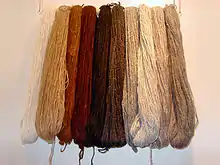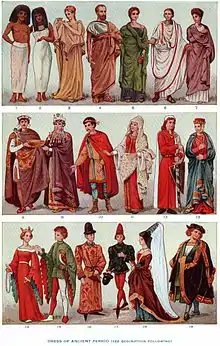Draped garment
A draped garment is a garment that is made of an entire piece of cloth; pieces are not cut away as in a fitted garment. It can be held to the body by means of draping, knotting, fixing with pins, fibulae, clasps, sashes or belts, tying, or friction and gravity alone. Many draped garments are one-piece garments.[1][2]
.jpeg.webp)
History
Draping is a most ancient and widespread form of clothing. Many visual arts of the Romans and Indian sculptures, terracottas, cave paintings, and wood carvings (also shown in picture gallery) conferring men and women wore the same (unstitched) clothes with various wrapping and draping styles. Uttariya, and Antariya are few evident clothing items of draped garments from the Vedic period. Kasaya, another rectangular piece of the Buddhist robe, is a real example of the draped garment. Further evolved forms are Sari, and Odhni, etc.[3][4][5] [6][7]
The kāṣāya also called jiāshā (Chinese: 袈裟), Kasaya consists of three pieces i.e the saṃghāti the most visible part of the buddhist attire. It comes over the upper robe (uttarāsaṅga). Uttarāsaṅga is a robe covering the upper body.[8] It comes over the undergarment, or antarvāsa. The antarvāsa is the inner robe covering the lower body. The latter are covered with saṃghāti.[9]
More examples of draped clothing are:
Examples
- Uttariya an upper body garment.
- Adivasah is a loose-fitting outer garment, it is a type of over garment similar to a mantle or cloak
- Antariya a lower body garment.
- Angvastra a kind of stole.
- Various kind of headdresses for the protection and adornment of the head.
- Stanapatta a chest band to cover the breasts.
- Sari is a draped garment of south asia, typically wrapped around the waist, with one end draped over the shoulder, partly baring the midriff.
- traditional kilts and belted plaids
- Peplos Long draped garment worn by women of Ancient Greece; often open on one side, with a deep fold at the top, and fastened on both shoulders.
- Palla (garment) a long rectangular piece of cloth, folded in half lengthwise and used as a cloak by Roman women.
- chitons
- loincloths
- togas a very long length of woolen fabric that Romans wrapped around themselves, draping it over the left shoulder and arm and leaving the right arm free.
- stolas long full robe with or without sleeves and drawn in with a belt; it was worn by Roman women, corresponding to the toga, that was worn by men. The stola was usually woollen.
- sarongs or lungis
- pareos
- longyis
- dhotis
- ponchos
- cloaks
- shawls
- Scarf
- Veshti a cloth wrap for the lower body in the Southern India.
Picture gallery
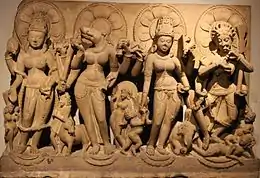
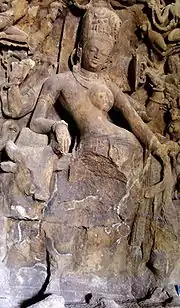 In Shakta theology, the female and male are interdependent realities, represented with Ardhanarishvara icon. Left: A 5th century art work representing this idea at the Elephanta Caves; Right: a painting of Ardhanarishvara.
In Shakta theology, the female and male are interdependent realities, represented with Ardhanarishvara icon. Left: A 5th century art work representing this idea at the Elephanta Caves; Right: a painting of Ardhanarishvara..jpg.webp) Yakshini wearing dhoti wrap and elaborate necklace, Mauryan period.
Yakshini wearing dhoti wrap and elaborate necklace, Mauryan period.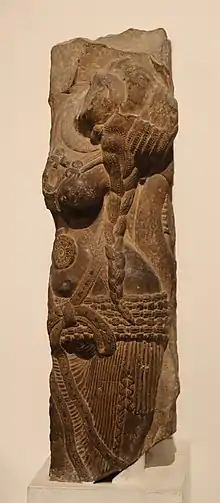 The "Mehrauli Yakshi", dated to 150 BCE, Mathura.
The "Mehrauli Yakshi", dated to 150 BCE, Mathura.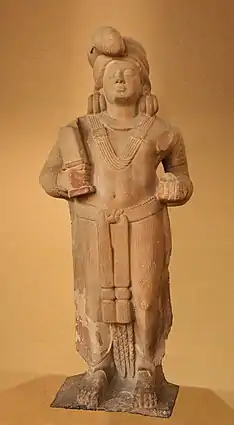 Mudgarpani Yaksha, 100 BCE.
Mudgarpani Yaksha, 100 BCE.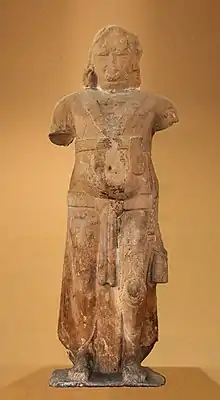 Parkham Yaksha, 150 BCE.
Parkham Yaksha, 150 BCE. Females statues wearing drapes are depicted at Dashavatara Temple.
Females statues wearing drapes are depicted at Dashavatara Temple.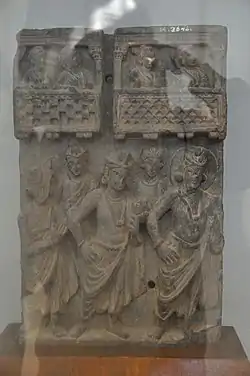
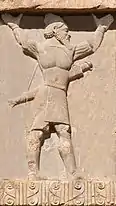
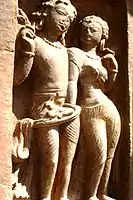 Male and female statues wearing drapes at Nachna Hindu temples.
Male and female statues wearing drapes at Nachna Hindu temples.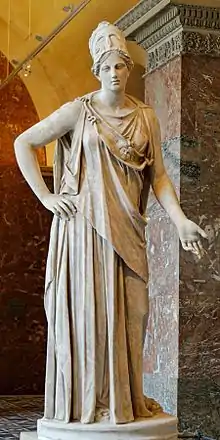 So-called “Mattei Athena”. Marble, Roman copy from the 1st century BC/AD after a Greek original of the 4th century BC, attributed to Cephisodotos or Euphranor. Related to the bronze Piraeus Athena.
So-called “Mattei Athena”. Marble, Roman copy from the 1st century BC/AD after a Greek original of the 4th century BC, attributed to Cephisodotos or Euphranor. Related to the bronze Piraeus Athena.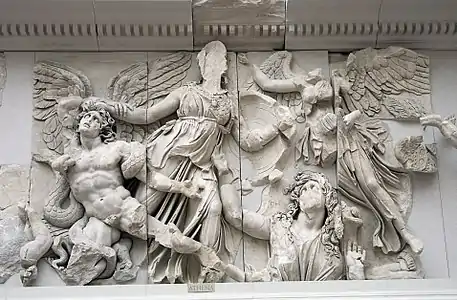 Relief of Athena and Nike slaying the Gigante Alkyoneus (?) from the Gigantomachy Frieze on the Pergamon Altar (early second century BC)
Relief of Athena and Nike slaying the Gigante Alkyoneus (?) from the Gigantomachy Frieze on the Pergamon Altar (early second century BC)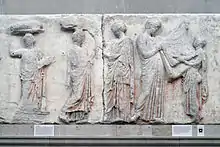 A new peplos was woven for the patron of craft and weaving and ceremonially brought to dress her cult image (British Museum).
A new peplos was woven for the patron of craft and weaving and ceremonially brought to dress her cult image (British Museum).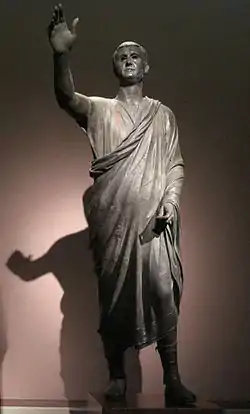 The Orator, c. 100 BC, an Etrusco-Roman bronze statue depicting Aule Metele (Latin: Aulus Metellus), an Etruscan man wearing a Roman toga while engaged in rhetoric; the statue features an inscription in the Etruscan alphabet
The Orator, c. 100 BC, an Etrusco-Roman bronze statue depicting Aule Metele (Latin: Aulus Metellus), an Etruscan man wearing a Roman toga while engaged in rhetoric; the statue features an inscription in the Etruscan alphabet_01.jpg.webp) Roman marble torso from the 1st century AD, showing a woman's clothing
Roman marble torso from the 1st century AD, showing a woman's clothing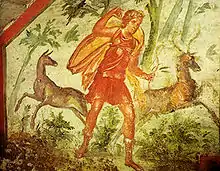 The goddess Diana hunting in the forest with a bow, and wearing the high-laced open "Hellenistic shoe-boots" associated with deities, and some images of very high status Romans. From a fresco in the Via Livenza Hypogeum, Rome, c. 350 AD
The goddess Diana hunting in the forest with a bow, and wearing the high-laced open "Hellenistic shoe-boots" associated with deities, and some images of very high status Romans. From a fresco in the Via Livenza Hypogeum, Rome, c. 350 AD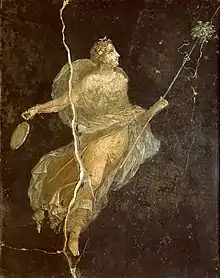
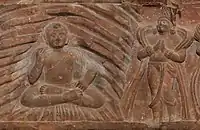 Uttariya and Antriya both are visible.
Uttariya and Antriya both are visible. A Mathura standing Buddha in "Samghati" monastic dress, circa 2nd century CE, Mathura Museum
A Mathura standing Buddha in "Samghati" monastic dress, circa 2nd century CE, Mathura Museum.jpg.webp) The Buddha in checkered monastic dress in the "Subjugation of Nalagiri", Bhutesvara Yakshis, 2nd century CE, Mathura.
The Buddha in checkered monastic dress in the "Subjugation of Nalagiri", Bhutesvara Yakshis, 2nd century CE, Mathura.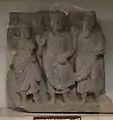 "Buddha Refuses Anupama", late Kushan
"Buddha Refuses Anupama", late Kushan Bodhisattva Avalokitesvara holding lotus flower
Bodhisattva Avalokitesvara holding lotus flower Naigamesha Jain god of Childbirth, 1st-3rd century CE.
Naigamesha Jain god of Childbirth, 1st-3rd century CE.
References
- Priest; Faiola-Priest, Theodora (1990). Guide to Clothing. McGraw-Hill School Division. p. 55. ISBN 978-0-07-050943-6.
- Beck, Astrid B. (1995). Fortunate the Eyes that See: Essays in Honor of David Noel Freedman in Celebration of His Seventieth Birthday. William B. Eerdmans Publishing Company. pp. 534, 540. ISBN 978-0-8028-0790-8.
- Tripathi, Ratikanta (1987). Social and Religious Aspects in Bengal Inscriptions. Firma KLM. p. 98.
- Biswas, A. (2017-09-15). Indian Costumes. Publications Division Ministry of Information & Broadcasting. ISBN 978-81-230-2564-3.
- "The history of sari: The nine yard wonder - Times of India". The Times of India. Retrieved 2021-01-21.
- Kumar, Ritu (2006). Costumes and Textiles of Royal India. Antique Collectors' Club. pp. 14, 16. ISBN 978-1-85149-509-2.
- Besancenot, Jean (1990). Costumes of Morocco. Kegan Paul International. p. 198. ISBN 978-0-7103-0359-2.
- Monier-Williams, Sir Monier (2014-11-06). Buddhism, In its Connexion With Brahmanism and Hinduism, and In Its Contrast with Christianity. New York: Macmillan And Co.
- Rienjang, Wannaporn; Stewart, Peter (2020-09-02). The Global Connections of Gandhāran Art: Proceedings of the Third International Workshop of the Gandhāra Connections Project, University of Oxford, 18th-19th March, 2019. Classical Art Research Centre. p. 171. ISBN 978-1-78969-696-7.

